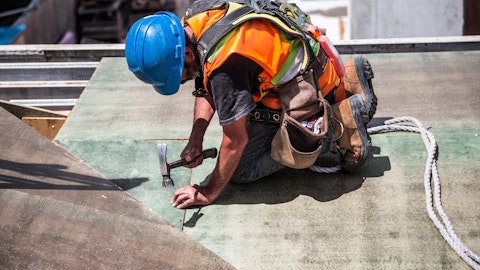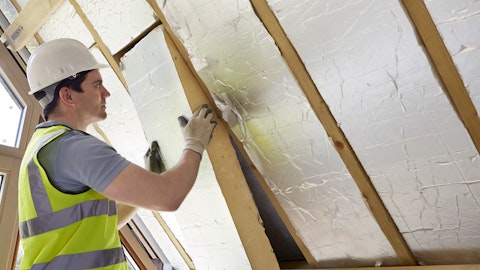Builders FirstSource, Inc. (NYSE:BLDR) Q3 2023 Earnings Call Transcript November 1, 2023
Builders FirstSource, Inc. beats earnings expectations. Reported EPS is $4.24, expectations were $4.05.
Operator: Good day. And welcome to the Builders FirstSource Third Quarter 2023 Earnings Conference Call. Today’s call is scheduled to last about one hour, including remarks by management and the question-and-answer session. [Operator Instructions] I’d now like to turn the call over to Heather Kos, Senior Vice President, Investor Relations for Builders FirstSource. Please go ahead.
Heather Kos: Good morning. And welcome to our third quarter earnings call. With me on the call are Dave Rush, our CEO; and Peter Jackson, our CFO. The earnings press release and investor presentation are available on our website at investors.bldr.com. We will refer to several slides from the investor presentation during our call. The results discussed today include GAAP and non-GAAP results adjusted for certain items. We provide these non-GAAP results for informational purposes and they should be considered in isolation from the most directly comparable GAAP measures. You can find the reconciliation of these non-GAAP measures to the corresponding GAAP measures where applicable and a discussion of why we believe they can be useful to investors in our earnings press release, SEC filings and presentation.

A builder wearing a hard hat admiring a newly constructed smart home.
Our remarks in the press release, presentation and on this call contain forward-looking and cautionary statements within the meaning of the Private Securities Litigation Reform Act and projections of future results. Please review the forward-looking statements section in today’s press release and in our SEC filings for various factors that could cause our actual results to differ from forward-looking statements and projections. With that, I’ll turn the call over to Dave.
Dave Rush: Thank you, Heather. Good morning, everyone, and thanks for joining our call. Before we begin, I want to formally welcome Heather to the Builders FirstSource team. We are excited to have someone with her deep knowledge and decades of experience leading Investor Relations, which is a critical function here. Heather, welcome. Now on to our Q3 performance. Despite industry volatility caused by macroeconomic headwinds, our resilient third quarter results reflect the strength of our value-added portfolio, broad footprint and operational initiatives we have put in place over the past several years. While challenges remain due to inflation and increasing mortgage rates, we continue to generate healthy margins. This is proof of our attractive product mix and the benefits of our investments in multifamily.
We remain confident in our 2023 outlook, as we focus on being the best partner for our customers and executing our strategy to drive long-term growth. We continue to create robust free cash flow and invest in the business to operate more efficiently, increase customer loyalty and expand our footprint. We are committed to operational excellence, including capturing efficiencies in our supply chain, as well as investing in automation and process improvements. These efforts are driving productivity savings and helping address our customers’ labor challenges now and into the future. We are helping our customers reduce cycle times, which is highlighted by improving our in-full deliveries from 94% last year to 96% during the third quarter. On-time and in-full deliveries ensure our customers have the right material at the right time, building their loyalty and trust in us.
We are continuing our investments in value-added solutions organically and through M&A to help our customers build more efficiently. These accretive acquisitions have enhanced our value-added product coverage and helped us achieve a leading position in desirable markets. As we grow share in these higher margin products, we are driving mixed improvement across the business. Our strong free cash flow provides multiple paths for capital deployment, all towards creating shareholder value. Given the long runway of potential tuck-ins, we will remain acquisitive to bolster our growth potential, while maintaining a disciplined focus on the highest return opportunities. Looking at our third quarter highlights on slide four, gross margin was approximately 35% and only down slightly on a sequential basis.
Despite normalization in core margins, our overall margins have remained resilient, primarily due to stronger mix in value-added products, including our multifamily business and improved manufacturing efficiencies. Our adjusted EBITDA margin also remains strong, highlighting our ability to manage our operations effectively in a challenging and dynamic environment. This execution is a reflection of our talented and focused field leadership team. Turning to slide five, we generated strong productivity savings of $54 million during the quarter. This reflects the effectiveness of our BFS One Team Operating System, which delivers value across the business by building people, excellence and growth. Our recent acquisitions in multifamily contributed an increase of 2% in sales and 4% in EBITDA compared to the prior year quarter.
Multifamily remained a tailwind this quarter and we expect this strength to continue for the remainder of 2023 before declining around the second quarter of next year. Disciplined SG&A expense management remains a key focus area. This includes the ongoing optimization of our footprint and balancing the need for cost reductions against future capacity needs. We are focused on our discretionary spending and our team has responsibly managed cost in the short-term, while executing our strategy for the long-term. Regarding our industry, the national builders have reported resilient results by providing incentives such as interest rate buydowns to ease affordability challenges and attract prospective buyers. The limited inventory of existing homes for sale is also steering traffic to new construction.
As we look forward to 2024, we will maintain our best-in-class customer service, continue our emphasis on expanding our value-added product mix and launch our BFS digital tool to make building process faster, more efficient and more affordable. Turning to M&A on slide six, we continue to target attractive opportunities while remaining financially disciplined. Through the third quarter, we have completed five deals with aggregate prior year sales of roughly $350 million. In September, we acquired Frank’s Cash & Carry, a leading building material distributor with trust manufacturing in the Florida Panhandle. We are pleased that this acquisition will help us grow with builders in the area. And earlier in the third quarter, we acquired Church’s Lumber, which expanded our presence in the Detroit market.
We’re excited to welcome these talented new team members to the BFS family. As shown on slide six, our M&A and organic investments have substantially increased our value-added product mix and diversified our end markets. We have seen the fruit of this growth in recent quarters through higher gross margins, even in a down housing market. Moving to slide seven, I would like to provide an update on capital allocation. During the third quarter, we prudently deployed capital in line with our stated priorities. We made two tuck-in acquisitions and repurchased over $200 million of shares, while maintaining a strong balance sheet. We have cumulatively deployed approximately $5.7 billion since the end of 2021 and remain on track to achieve our 2025 goal of deploying $7 billion to $10 billion of capital, as communicated our Investor Day in December 2021.
Now let’s turn to slide eight and nine for an update on our digital strategy. We are steadfast in our commitment to leading the digital evolution in our industry and generating new innovations to drive greater efficiency across home building and enhance our product and service offerings. As we look forward to our full product launch in Q1, we have made it a priority to drive digital adoption across our operations. myBLDR.com is designed to create efficiencies for both our team members and customers by offering improved transparency and engagement in the homebuilding process. Taking with our proprietary estimating and configuration tools, this gives our customers more control over the entire building process, saving both time and money for our customers and their clients, while making the homebuilding process more personalized.
In the third quarter, we continued our product development and adoption efforts as we prepare for the upcoming full product launch. These are important milestones in our journey to reshape the industry and extend our lead as the partner of choice in the market and attain our goal of $1 billion in incremental sales by 2026. We look forward to sharing more information with you at our Investor Day next month. At BFS, we pride ourselves on helping our people achieve their career goals. A team member who has taken full advantage of every growth opportunity presented to her is Sue Dean, the General Manager of our Florence, South Carolina location. Through the various roles she’s held over her more than 40 years with BFS, she’s earned the nickname Sue Deany for her ability to solve problems and make magic happen.
Since being promoted as General Manager, Sue has led her location to achieve exceptional results by recognizing her team members’ potential and empowering them. It’s stories like Sue’s that made me excited to see all the different ways our team members can grow here at BFS. I’ll now turn the call over to Peter to discuss our third quarter financial result in greater detail.
Peter Jackson: Thank you, Dave, and good morning, everyone. Our third quarter results demonstrate the effectiveness of our operating model in the face of macro volatility. We are maintaining a healthy balance sheet and prudently deploying capital to the highest return opportunities, which included share repurchases during the quarter. We are leveraging our sustainable competitive advantages and strong financial position to drive future growth and value creation for our shareholders. I will cover three topics with you this morning. First, I’ll recap our third quarter results. Second, I’ll provide an update on capital deployment. And finally, I’ll discuss our full year 2023 guidance and 2024 scenarios. Let’s begin by reviewing our third quarter performance on slides 10 and 11.
We delivered $4.5 billion in net sales. For organic sales decreased by 14%, driven by a 19% decline in single-family due to slower demand over the prior year, supply chain normalization and commodity deflation of approximately 9%. Multifamily grew by over 6%, driven by our recent acquisitions, as well as favorable margins, largely attributable to the longer lead time for this end market. R&R and other grew by over 1% amid increased sales focus and capacity versus the prior year. The cumulative effect of our acquisitions over the past year contributed approximately 3 percentage points of growth to net sales. Importantly, value-added products represented 51% of our net sales this quarter, increasing 6 percentage points since Investor Day in Q4 2021.
This reflects our position as the supplier of choice for these higher margin products. During the third quarter, gross profit was $1.6 billion, a decrease of approximately 22% compared to the prior year period. Gross margins were 34.9%, decreasing 10 basis points due to normalization in core organic gross margins, offset by roughly 125 basis points of our previously discussed multifamily over earning. SG&A decreased $61 million to $940 million, mainly due to lower variable compensation, partially offset by additional expenses from operations acquired in the last year and inflation. Acquisitions increased SG&A by $34 million in the quarter. As a percentage of net sales, total SG&A increased by 330 basis points to 20.7%, primarily attributable to decreased fixed cost leverage from lower sales.
We remain focused on operating efficiently, containing costs and effectively integrating acquisitions. Adjusted EBITDA was approximately $813 million, down 31%, primarily driven by lower net sales due to a weaker housing market and commodity deflation. Adjusted EBITDA margin remained a robust 17.9%, up 90 basis points sequentially as we continue to execute and drive improved productivity across the business. Adjusted net income of $534 million was down $280 million from the prior year quarter. The 34% decrease was largely due to lower net sales. Adjusted earnings per diluted share was $4.24, down 19%, compared to $5.20 in the prior year period. On a year-over-year basis, share repurchases added roughly $0.83 per share. Now let’s turn to our cash flow, balance sheet and liquidity on slide 12.
Our third quarter operating cash flow was approximately $665 million, down $835 million, compared to the prior year period, mainly attributable to commodity deflation and a weaker housing market. Capital expenditures were $128 million. All in, we delivered healthy free cash flow of approximately $538 million. For the trailing 12 months ended September 30th, our free cash flow yield was 14.1%, while operating cash flow return on invested capital was 32%. Our net debt to adjusted EBITDA ratio was approximately 1.1 times, while base business leverage was 1.5 times. Excluding our ABL, we have no long-term debt maturities until 2030. At quarter end, our total liquidity was approximately $1.1 billion, consisting of $1 billion in net borrowing availability under the revolving credit facility and $100 million of cash on hand.
Moving to capital deployment, during the third quarter, we repurchased approximately 1.7 million shares for $224 million at an average stock price of $136.22 per share. Year-to-date, we have repurchased nearly $1.6 billion of shares at an average price of $97.43 per share. We have approximately $400 million remaining on our most recent $1 billion share repurchase program, approved in April of 2023. We remain disciplined stewards of capital and have multiple paths for value creation through a proven ability to deploy capital and deliver high returns. Now let’s turn to our outlook on slide 13. Given affordability headwinds, our Q3 sales were a little softer than expected. However, the October sales trend was seasonally healthy, and our focus — our continued focus and execution gives us confidence that we will achieve our full year base business and total company EBITDA guidance for 2023 that we outlined in our second quarter earnings call.
For full year 2023, we expect total company net sales to be $16.8 billion to $17.1 billion. We expect adjusted EBITDA to be $2.7 billion to $2.8 billion. Adjusted EBITDA margin is forecasted to be 15.8% to 16.7%. We are guiding gross margins to a range of 34% to 35%. Our recent above-normal margins reflect a greater mix of value-added products, along with disciplined pricing required to offset increased operating costs. As we move through the end of the year, we expect both our gross margins and the multifamily business to continue to normalize. We expect full year 2023 free cash flow of $1.8 billion to $2 billion. The free cash flow forecast assumes average commodity prices in the range of $400 to $425. Our 2023 outlook is based on several assumptions.
Please refer to our earnings release and slide 14 of the investor presentation for a full list of these assumptions. Turning to slides 15 and 16, as a reminder, our base business approach showcases the underlying strength and profitability of our company by normalizing sales and margins for commodity volatility. This helps to clear — to clearly assess the core aspects of the business where we have focused our attention to drive sustainable outperformance. Our base business guide on net sales is $16.4 billion. Our base business EBITDA guide is $2.2 billion at a margin of 13.5%. Moving to slide 17, we recognize that 2024 is coming into focus as we approach year end. Like we did earlier this year, we have laid out a scenario analysis to demonstrate how we are positioned to generate resilient financial performance across a range of potential housing market and commodity conditions.
I want to emphasize that this is not full year guidance for 2024, but these scenarios should help clarify our range of performance expectations for 2024 and demonstrate the strength of our best-in-class operating platform. As I wrap up, I want to reiterate that we are confident in the near-term outlook, our exceptional positioning to execute our strategic goals and our ability to create value in any environment to support profitable growth. With that, let me turn the call back over to Dave for some final thoughts.
Dave Rush: Thanks, Peter. Let me close by saying that we’re executing on our strategic pillars to deliver long-term value creation. Our tireless team effort has resulted in a differentiated platform, setting us up for above market growth and exceptional profitability for years to come. I continue to be proud of our operational excellence, which is driving increased safety, productivity and profitability despite market headwinds. We are in a great position today and as end markets further stabilize, we are positioned for an even stronger future. We’ll remain at the forefront of technology with our BFS digital tool, which I’m confident will be a game-changer for the industry. We are exceptionally well-positioned in the marketplace to navigate complex operating environments due to our value-added solutions, fortress balance sheet and strong free cash flow generation.
We’re excited to share more details about our longer term vision at our upcoming Investor Day on December 5th in Atlanta and look forward to seeing you there. Thank you again for joining us today. Operator, let’s please open the call now for questions.
See also 25 Funny Prank Call Ideas for your Boyfriend and 12 Best Free Accounting Software in 2023.
Q&A Session
Follow Builders Firstsource Inc. (NASDAQ:BLDR)
Follow Builders Firstsource Inc. (NASDAQ:BLDR)
Operator: Thank you. [Operator Instructions] And our first question comes from Matthew Bouley with Barclays.
Matthew Bouley: Hi, everyone. Thank you for taking the questions. I think it’s very helpful that you outlined those 2024 framework assumptions here, especially as you look ahead to the Investor Day, perhaps, precluding some of that line of questioning so you can focus a bit more the longer term. So my questions will focus on that. I think I see in the footnote that you are making assumptions about multifamily and R&R into 2024. I think, Dave, earlier you made a very specific comment that multifamily could turn in the second quarter of next year. So my question is, how is multifamily contemplated from both a growth and margin perspective in that 2024 framework? Thanks, guys.
Dave Rush: Yeah. Thanks, Matt. Appreciate the question. As you know, the multifamily projects have a longer life cycle, tend to be 19 months to 18 months. So what we’re seeing in the backlog right now is healthy and will carry us through the first quarter of next year. What’s changing, the dynamic that’s changing a bit is the projects, the new projects are slower to come to market. We believe there’s going to be a pause in some of the multifamily as the market digests what’s coming, what’s completing throughout this year and as they figure out the right balance between cost of capital and rents and what return they can get on the rents, we just think there’s going to be a temporary pause and then things will start up again at the tail end of 2024. But again, because there’s such a long cycle for those projects to get into the ground, we won’t necessarily see that effect in 2024. So we’re forecasting for multifamily to be off in 2024 as a result.
Peter Jackson: Yeah. Just to add to it. I think it’s the theme of normalization. We’ve seen such displacement in the industry over the last couple of years, multifamily included. You’re going to see that theme, I think, in a lot of what we’re talking about. Things are going well, but certainly normalizing back from some of that displacement.
Matthew Bouley: Got it. Okay. Thanks for that, guys. Very helpful. And then second one, the — I’m sticking on the framework here. On the single-family side, I guess, it’s two parter. Number one, the low end of a down 4%, just given where interest rates are and a lot of the questions out there, the question is effectively why not outline a lower end? And in that scenario of a lower end, would you be able to kind of push any harder on cost out? So that’s kind of part one of the question. And then part two is just, given the sort of mid-teens EBITDA margin you’re guiding to, I guess, what is the sort of implied gross margin in that? I know there’s a lot in there, but thanks, guys.
Peter Jackson: Yeah. So, I think, a couple of factors. The first is that we harvested the feedback from the economists. That’s generally what we lean on, just like everybody else when it comes to the expectations for next year. We certainly try and temper it a little bit by, let’s say, eliminating as statisticians do the high and the low end or the ones that look ridiculous in terms of trying to come up with a real number. Up until very recently, I would tell you that the sense was that we would see some nice growth next year. Admittedly, some of the more recent revisions from the economists have pulled it back, but I still think it’s fairly favorable. So, what will play out?
Matthew Bouley: Sure.
Peter Jackson: That’s a fair — it’s a fair comment. Really, the reason why we gave the range that we did is we think there are a number of scenarios that could play out. If you want to go below the low end of this, I love the question because I think what you didn’t ask is as informative as anything and that’s nobody’s challenging our double-digit margins, even when the market’s down. And that’s because we’ve demonstrated an ability to maintain those margins, to see healthy profitability, to benefit from the mix of our business and we expect to continue to be able to do that. Now, we’ll certainly retain our discipline around costs. We’ll continue to resize facilities and markets, depending on what the starts number is and what the business looks like.
But I think our theme around here is really about consistent performance and operational excellence and not really seeing a huge need to do something unwise for the business, but just keep doing what we’re doing because we’re seeing great results.
Dave Rush: And just to add, Matt, it’s continued to drive costs out of the business that don’t add value, the benefit of our platform and the fact that we’ve done the hard work in the last two years to integrate these companies. We have a 30-year average experience with our field leadership group. They know what to do, when to do it and how to manage those costs effectively to maximize whatever is presented to us. And we’ve identified a lot of opportunities to continue to focus on productivity and where we are now is we don’t have to keep reinventing those opportunities because our scale allows us to push that across the platform and we have plenty of runway to take existing ideas in the markets that we haven’t been able to push those ideas yet just because of our scale and find — keep finding dollars to save.
Matthew Bouley: Got it. That’s super helpful. And on my question, did you have anything around the gross margin expectation within that mid-teens EBITDA guide?
Peter Jackson: We won’t give anything specific, but I think it’s fair to say we do expect to see normalization into 2024, that pullback, the reversal of the multifamily in particular. But overall, that normalization theme, I think, applies to margins as well.
Matthew Bouley: Got it. Appreciate the very comprehensive answers, guys. See you in Atlanta in a month. Thank you.
Dave Rush: Thanks, Matt.
Peter Jackson: Thanks.
Operator: And we have our next question from Trey Grooms with Stephens.
Trey Grooms: Hey. Good morning, everyone.
Dave Rush: Hi.





